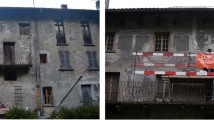Abstract
With atmospheric pollution causing building stone to decay at accelerated rates, conservation of historic stone monuments is becoming an increasingly important issue. Mortar joints have a marked effect on how moisture moves in a wall and, hence, on how the wall weathers. Not only does mortar bind stones together, but also a good mortar will prevent the ingress of moisture (and pollutants), enable the buildings to dry out, accommodate movement and will not act as a source of harmful chemicals capable of attacking the surrounding stone. Thus, poor mortar can have deleterious effects on the stonework. This paper, which is the result of research sponsored by the Commission of European Communities, considers a number of commonly used, and some more rarely used, pointing mortars, and assesses them with a view to using the most successful for repointing a historic stone building in Trinity College, Dublin.
Resume
Dans le cadre d’un programme de conservation et de maintenance, Trinity College, Dublin, a décidé de rejointoyer, après grattage de l’ancien mortier, l’ensemble d’un important bâtiment historique. Les options disponibles à l’époque étaient les suivantes: soit suivre les pratiques ‘traditionnelles’, telle l’utilisation de mortier à la chaux, soit utiliser les mortiers de ciment modernes. On disposait de peu de certitude scientifique pour guider le choix. Le collège prit donc la décision d’entreprendre des essais afin de pouvoir évaluer les choix possibles.
On résume ici les caractéristiques les plus importantes d’un mortier de rejointoiement, et les problèmes qu’elles sont susceptibles de causer dans les murs. On a évalué à l’aide d’essais mécaniques et chimiques un certain nombre de mortiers (mortiers ciment/chaux, ciment/plastifiant, ciment/hydroxyde de barium, ciment/cendres volantes). Au bout du compte, on a choisi d’utiliser un mortier de sable/ciment dans la proportion 9∶1 pour le programme de restauration de Trinity College. On décrit les problèmes liés au grattage et au rejointoiement.
Similar content being viewed by others
References
Johnson, J., Haneef, S., Hepburn B., Hutchinson, A., Thompson, G. and Wood, G., ‘Laboratory exposure systems to simulate atmospheric degradation of building stone under dry and wet deposition conditions’,Atmos. Envir. 24A (10) (1990) 2585–2592.
Cooper, T., Dowding, P., Lewis, J. O., Mulvin, L., O’Brien, P., Olley, J. and O’Daly, G., ‘Contribution of calcium from limestone and mortar to the decay of granite walling’, in Proceedings of Conference on Science, Technology and European Cultural Heritage, Bologna, 1989, pp. 456–461.
Feilden, B., ‘Conservation of Historic Buildings’, 1st Edn (Butterworth, London, 1982).
BRE Digest 160:1973, ‘Mortars for Bricklaying’ (Buildings Research Establishment, London, 1973).
Beningfield, N., ‘Aspects of cement-based mortars for brickwork and blockwork’,Concrete 14 (1) (1980) 27–30.
Nash, W., “Brickwork Repair and Restoration’, 1st Edn (Attic Books, Sussex, 1986).
Amoroso, G. and Fassina, V., ‘Stone Decay and Conservation’, 1st Edn. (Elsevier, Amsterdam, 1983).
Livingston, R. and Baer, S., ‘Mechanisms of air pollution-induced damage to stone’, in Proceedings of 6th World Congress on Air Quality, Paris, May 1983, Vol. 3, pp. 33–40.
Binda, L., Baronio, G. and Charola, A., ‘Deterioration of porous materials due to salt crystallization under different thermohygrometric conditions, 1: Brick’, in Proceedings of 5th Congress on the Deterioration and Conservation of Stone, Lausanne, September 1985, Vol. 1 (Presses Polytechniques Romandes, Lausanne, 1985) pp. 279–288.
Schaffer, R., ‘The Weathering of Natural Building Stones’, 1st Edn. (His Majesty’s Stationery Office, London, 1932).
Harvey, J., ‘Conservation of Buildings’, 1st Edn (Baker, London, 1972).
‘Handbook of Chemistry and Physics’, 63rd Edn (CRC Press, Florida, 1982).
Author information
Authors and Affiliations
Rights and permissions
About this article
Cite this article
Duffy, A.P., Cooper, T.P. & Perry, S.H. Repointing mortars for conservation of a historic stone building in Trinity College, Dublin. Materials and Structures 26, 302–306 (1993). https://doi.org/10.1007/BF02472952
Issue Date:
DOI: https://doi.org/10.1007/BF02472952




